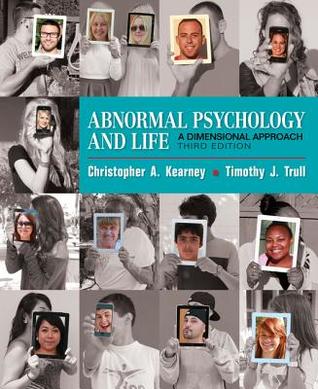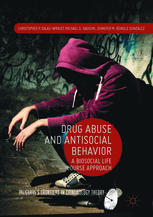Abnormal Psychology and Life A Dimensional Approach 3rd Edition by Chris Kearney , Timothy Trull ISBN 1337098108 978-1337098106
$50.00 Original price was: $50.00.$25.00Current price is: $25.00.
Abnormal Psychology and Life A Dimensional Approach 3rd Edition by Chris Kearney , Timothy Trull – Ebook PDF Instant Download/Delivery:1337098108, 978-1337098106
Full download Abnormal Psychology and Life A Dimensional Approach 3rd Edition after payment

Product details:
ISBN 10: 1337098108
ISBN 13: 978-1337098106
Author: Chris Kearney , Timothy Trull
Chris Kearney and Tim Trull’s ABNORMAL PSYCHOLOGY AND LIFE: A DIMENSIONAL APPROACH provides you with a concise, contemporary, science-based view of psychopathology that emphasizes the individual first. Featuring clinical cases and real first-person narratives, the text illuminates our understanding that abnormal behavior can be viewed along a continuum. This widely accepted view places the behavior of an individual at the forefront of clinical definition, assessment, and treatment. The book also gives you an understanding of the features and epidemiologies, risk factors and prevention, assessment and treatment, and long-term prognosis and associated stigma of mental disorders. Special sections are devoted to college students, ideas for those who may have certain symptoms of mental disorders, and other consumer-based material — demonstrating how the subject is personally relevant to you and helping you become an intelligent consumer of mental health information.
Table of contents:
Chapter 1. Abnormal Psychology and Life
Introduction to Abnormal Psychology
What Is a Mental Disorder?
Deviance from the Norm
Difficulties Adapting to Life Demands
Experience of Personal Distress
Defining Abnormality
Dimensions Underlying Mental Disorders Are Relevant to Everyone
Interim Summary
Review Questions
History of Abnormal Psychology
Early Perspectives
Early Greek and Roman Thought
Middle Ages
Renaissance
Reform Movement
Modern Era
Interim Summary
Review Questions
Abnormal Psychology and Life: Themes
Dimensional Perspective
Prevention Perspective
Consumer Perspective
Diversity
Stigma
Interim Summary
Review Questions
Final Comments
Key Terms
Chapter 2. Perspectives on Abnormal Psychology
Introduction
The Biological Model
Genetics
Nervous Systems and Neurons
Brain
Biological Assessment and Treatment
Evaluating the Biological Model
Interim Summary
Review Questions
The Psychodynamic Model
Brief Overview of the Psychodynamic Model
Psychodynamic Assessment and Treatment
Evaluating the Psychodynamic Model
Interim Summary
Review Questions
The Humanistic Model
Abraham Maslow
Carl Rogers
Rollo May
Humanistic Assessment and Treatment
Evaluating the Humanistic Model
Interim Summary
Review Questions
The Cognitive-Behavioral Model
Behavioral Perspective
Cognitive Perspective
A Cognitive-Behavioral Model
Cognitive-Behavioral Assessment and Treatment
Evaluating the Cognitive-Behavioral Model
Interim Summary
Review Questions
The Sociocultural Model
Culture
Gender
Neighborhoods and Communities
Family
Sociocultural Assessment and Treatment
Evaluating the Sociocultural Model
Interim Summary
Review Questions
Final Comments
Key Terms
Chapter 3. Risk and Prevention of Mental Disorders
The Diathesis-Stress Model
Diathesis, Stress, and Mental Health
Diathesis-Stress: The Big Picture
Diathesis-Stress: The Little Picture
Implications of the Diathesis-Stress Model
Interim Summary
Review Questions
Epidemiology: How Common Are Mental Disorders?
Prevalence of Mental Disorders
Treatment Seeking
Treatment Cost
Interim Summary
Review Questions
Risk, Protective Factors, and Resilience
Risk Factors
Protective Factors
Interim Summary
Review Questions
Prevention
Prevention on a Continuum
Three Types of Prevention
Prevention Programs for Mental Disorders
Interim Summary
Review Questions
Final Comments
Key Terms
Chapter 4. Diagnosis, Assessment, and Study of Mental Disorders
Defining Abnormal Behavior and Mental Disorder
Dimensions and Categories
DSM
Advantages of Diagnosis
Interim Summary
Review Questions
Classifying and Assessing Abnormal Behavior and Mental Disorder
Assessing Abnormal Behavior and Mental Disorder
Reliability, Validity, and Standardization
Interview
Intelligence Tests
Personality Assessment
Behavioral Assessment
Biological Assessment
Psychophysiological Assessment
Neuropsychological Assessment
Interim Summary
Review Questions
Culture and Clinical Assessment
Culture and the Development of Mental Disorders
Culture and Clinical Assessment
Interim Summary
Review Questions
Studying Abnormal Behavior and Mental Disorder
Experiment
Correlational Studies
Quasi-Experimental Methods
Other Alternative Experimental Designs
Developmental Designs
Case Study
Consuming the Media’s Research
Interim Summary
Review Questions
Final Comments
Key Terms
Chapter 5. Anxiety, Obsessive-Compulsive, and Trauma-Related Disorders
Worry, Anxiety, Fear, and Anxiety; Obsessive-Compulsive; and Trauma-Related Disorders: What Are They?
Anxiety, Obsessive-Compulsive, and Trauma-Related Disorders: Features and Epidemiology
Panic Attack
Panic Disorder
Social Phobia
Specific Phobia
Generalized Anxiety Disorder
Obsessive-Compulsive Disorder
Obsessive-Compulsive-Related Disorders
Posttraumatic Stress Disorder and Acute Stress Disorder
Separation Anxiety Disorder and School Refusal Behavior
Epidemiology of Anxiety, Obsessive-Compulsive, and Trauma-Related Disorders
Stigma Associated with Anxiety, Obsessive-Compulsive, and Trauma-Related Disorders
Interim Summary
Review Questions
Anxiety, Obsessive-Compulsive, and Trauma-Related Disorders: Causes and Prevention
Biological Risk Factors for Anxiety, Obsessive-Compulsive, and Trauma-Related Disorders
Environmental Risk Factors for Anxiety, Obsessive-Compulsive, and Trauma-Related Disorders
Causes of Anxiety, Obsessive-Compulsive, and Trauma-Related Disorders
Prevention of Anxiety, Obsessive-Compulsive, and Trauma-Related Disorders
Interim Summary
Review Questions
Anxiety, Obsessive-Compulsive, and Trauma-Related Disorders: Assessment and Treatment
Assessment of Anxiety, Obsessive-Compulsive, and Trauma-Related Disorders
Biological Treatment of Anxiety, Obsessive-Compulsive, and Trauma-Related Disorders
Psychological Treatments of Anxiety, Obsessive-Compulsive, and Trauma-Related Disorders
What If I Have Anxiety or an Anxiety-Related Disorder?
Long-Term Outcome for People with Anxiety, Obsessive-Compulsive, and Trauma-Related Disorders
Interim Summary
Review Questions
Final Comments
Thought Questions
Key Terms
Chapter 6. Somatic Symptom and Dissociative Disorders
Somatic Symptom and Dissociative Disorders: A Historical Introduction
Somatization and Somatic Symptom Disorders: What Are They?
Somatic Symptom Disorders: Features and Epidemiology
Somatic Symptom Disorder
Illness Anxiety Disorder
Conversion Disorder
Factitious Disorder and Malingering
Epidemiology of Somatic Symptom Disorders
Stigma Associated with Somatic Symptom Disorders
Interim Summary
Review Questions
Somatic Symptom Disorders: Causes and Prevention
Biological Risk Factors for Somatic Symptom Disorders
Environmental Risk Factors for Somatic Symptom Disorders
Causes of Somatic Symptom Disorders
Prevention of Somatic Symptom Disorders
Interim Summary
Review Questions
Somatic Symptom Disorders: Assessment and Treatment
Assessment of Somatic Symptom Disorders
Biological Treatment of Somatic Symptom Disorders
Psychological Treatments of Somatic Symptom Disorders
What If I or Someone I Know Has a Somatic Symptom Disorder?
Long-Term Outcome for People with Somatic Symptom Disorders
Interim Summary
Review Questions
Dissociative Disorders
Normal Dissociation and Dissociative Disorders: What Are They?
Dissociative Disorders: Features and Epidemiology
Dissociative Amnesia
Dissociative Identity Disorder
Depersonalization/Derealization Disorder
Epidemiology of Dissociative Disorders
Stigma Associated with Dissociative Disorders
Interim Summary
Review Questions
Dissociative Disorders: Causes and Prevention
Biological Risk Factors for Dissociative Disorders
Environmental Risk Factors for Dissociative Disorders
Causes of Dissociative Disorders
Prevention of Dissociative Disorders
Interim Summary
Review Questions
Dissociative Disorders: Assessment and Treatment
Assessment of Dissociative Disorders
Biological Treatment of Dissociative Disorders
Psychological Treatments of Dissociative Disorders
What If I or Someone I Know Has a Dissociative Disorder?
Long-Term Outcome for People with Dissociative Disorders
Interim Summary
Review Questions
Final Comments
Thought Questions
Key Terms
Chapter 7. Depressive and Bipolar Disorders and Suicide
Normal Mood Changes and Depression and Mania: What Are They?
Depressive and Bipolar Disorders and Suicide: Features and Epidemiology
Major Depressive Episode
Major Depressive Disorder
Persistent Depressive Disorder (Dysthymia)
Other Depressive Disorders
Manic and Hypomanic Episodes
Bipolar I Disorder
Bipolar II Disorder
Cyclothymic Disorder
Suicide
Epidemiology of Depressive and Bipolar Disorders
Epidemiology of Suicide
Stigma Associated with Depressive and Bipolar Disorders
Interim Summary
Review Questions
Depressive and Bipolar Disorders and Suicide: Causes and Prevention
Biological Risk Factors for Depressive and Bipolar Disorders and Suicide
Environmental Risk Factors for Depressive and Bipolar Disorders and Suicide
Causes of Depressive and Bipolar Disorders and Suicide
Prevention of Depressive and Bipolar Disorders and Suicide
Interim Summary
Review Questions
Depressive and Bipolar Disorders and Suicide: Assessment and Treatment
Interviews and Clinician Ratings
Self-Report Questionnaires
Self-Monitoring and Observations from Others
Laboratory Assessment
Assessment of Suicide
Biological Treatment of Depressive and Bipolar Disorders and Suicide
Psychological Treatments for Depressive and Bipolar Disorders and Suicide
What If I Am Sad or Have a Depressive or Bipolar Disorder?
Long-Term Outcome for People with Depressive and Bipolar Disorders and Suicide
Interim Summary
Review Questions
Final Comments
Thought Questions
Key Terms
Chapter 8. Eating Disorders
Weight Concerns, Body Dissatisfaction, and Eating Disorders: What Are They?
Eating Disorders: Features and Epidemiology
Anorexia Nervosa
Bulimia Nervosa
Binge-Eating Disorder
Epidemiology of Eating Disorders
Stigma Associated with Eating Disorders
Interim Summary
Review Questions
Eating Disorders: Causes and Prevention
Biological Risk Factors for Eating Disorders
Environmental Risk Factors for Eating Disorders
Causes of Eating Disorders
Prevention of Eating Disorders
Interim Summary
Review Questions
Eating Disorders: Assessment and Treatment
Assessment of Eating Disorders
Treatment of Eating Disorders
Biological Treatments of Eating Disorders
Psychological Treatments of Eating Disorders
What If I Have Weight Concerns or an Eating Disorder?
Long-Term Outcome for People with Eating Disorders
Interim Summary
Review Questions
Final Comments
Thought Questions
Key Terms
Chapter 9. Substance-Related Disorders
Normal Substance Use and Substance-Related Disorders: What Are They?
Substance-Related Disorders: Features and Epidemiology
Substance Use Disorder
Substance Intoxication
Substance Withdrawal
Types of Substances
Epidemiology of Substance-Related Disorders
Stigma Associated with Substance-Related Disorders
Interim Summary
Review Questions
Substance-Related Disorders: Causes and Prevention
Biological Risk Factors for Substance-Related Disorders
Environmental Risk Factors for Substance-Related Disorders
Causes of Substance-Related Disorders
Prevention of Substance-Related Disorders
Interim Summary
Review Questions
Substance-Related Disorders: Assessment and Treatment
Interviews
Psychological Testing
Observations from Others
Laboratory Testing
Biological Treatment of Substance-Related Disorders
Psychological Treatment of Substance-Related Disorders
What If I or Someone I Know Has a Substance-Related Problem or Disorder?
Long-Term Outcome for People with Substance-Related Disorders
Interim Summary
Review Questions
Final Comments
Thought Questions
Key Terms
Chapter 10. Personality Disorders
Personality Traits, Unusual Personality, and Personality Disorder: What Are They?
Organization of Personality Disorders
Odd or Eccentric Personality Disorders: Features and Epidemiology
Paranoid Personality Disorder
Schizoid Personality Disorder
Schizotypal Personality Disorder
Epidemiology of Odd or Eccentric Personality Disorders
Interim Summary
Review Questions
Dramatic Personality Disorders: Features and Epidemiology
Antisocial Personality Disorder
Borderline Personality Disorder
Histrionic Personality Disorder
Narcissistic Personality Disorder
Epidemiology of Dramatic Personality Disorders
Interim Summary
Review Questions
Anxious/Fearful Personality Disorders: Features and Epidemiology
Avoidant Personality Disorder
Dependent Personality Disorder
Obsessive-Compulsive Personality Disorder
Epidemiology of Anxious/Fearful Personality Disorders
Stigma Associated with Personality Disorders
Interim Summary
Review Questions
Personality Disorders: Causes and Prevention
Biological Risk Factors for Odd or Eccentric Personality Disorders
Environmental Risk Factors for Odd or Eccentric Personality Disorders
Causes of Odd or Eccentric Personality Disorders
Biological Risk Factors for Dramatic Personality Disorders
Environmental Risk Factors for Dramatic Personality Disorders
Causes of Dramatic Personality Disorders
Biological Risk Factors for Anxious/Fearful Personality Disorders
Environmental Risk Factors for Anxious/Fearful Personality Disorders
Causes of Anxious/Fearful Personality Disorders
Prevention of Personality Disorders
Interim Summary
Review Questions
Personality Disorders: Assessment and Treatment
Assessment of Personality Disorders
Biological Treatments of Personality Disorders
Psychological Treatments of Personality Disorders
What If I or Someone I Know Has a Personality Disorder?
Long-Term Outcomes for People with Personality Disorders
Interim Summary
Review Questions
Final Comments
Thought Questions
Key Terms
Chapter 11. Sexual Dysfunctions, Paraphilic Disorders, and Gender Dysphoria
Normal Sexual Behavior and Sexual Dysfunctions: What Are They?
Sexual Dysfunctions: Features and Epidemiology
Male Hypoactive Sexual Desire Disorder
Female Sexual Interest/Arousal Disorder
Erectile Disorder
Female Orgasmic Disorder
Delayed Ejaculation
Premature (Early) Ejaculation
Genito-Pelvic Pain/Penetration Disorder
Epidemiology of Sexual Dysfunctions
Stigma Associated with Sexual Dysfunctions
Interim Summary
Review Questions
Sexual Dysfunctions: Causes and Prevention
Biological Risk Factors for Sexual Dysfunctions
Psychological Risk Factors for Sexual Dysfunctions
Causes of Sexual Dysfunctions
Prevention of Sexual Dysfunctions
Interim Summary
Review Questions
Sexual Dysfunctions: Assessment and Treatment
Assessment of Sexual Dysfunctions
Biological Treatment of Sexual Dysfunctions
Psychological Treatments of Sexual Dysfunctions
What If I or Someone I Know Has a Sexual Dysfunction?
Long-Term Outcomes for People with Sexual Dysfunctions
Interim Summary
Review Questions
Normal Sexual Desires, Paraphilias, and Paraphilic Disorders: What Are They?
Paraphilic Disorders: Features and Epidemiology
Exhibitionistic Disorder
Fetishistic Disorder
Frotteuristic Disorder
Pedophilic Disorder
Sexual Masochism and Sexual Sadism
Transvestic Disorder
Voyeuristic Disorder
Atypical Paraphilic Disorders
Epidemiology of Paraphilic Disorders
Interim Summary
Review Questions
Paraphilic Disorders: Causes and Prevention
Biological Risk Factors for Paraphilic Disorders
Environmental Risk Factors for Paraphilic Disorders
Causes of Paraphilic Disorders
Prevention of Paraphilic Disorders
Interim Summary
Review Questions
Paraphilic Disorders: Assessment and Treatment
Assessment of Paraphilic Disorders
Biological Treatment of Paraphilic Disorders
Psychological Treatments of Paraphilic Disorders
What If I or Someone I Know Has a Paraphilic Disorder?
Long-Term Outcomes for People with Paraphilic Disorders
Interim Summary
Review Questions
Normal Gender Development and Gender Dysphoria: What Are They?
Gender Dysphoria: Features and Epidemiology
Gender Dysphoria: Causes and Prevention
Gender Dysphoria: Assessment and Treatment
Assessment of Gender Dysphoria
Biological Treatment of Gender Dysphoria
Psychological Treatment of Gender Dysphoria
What If I or Someone I Know Has Questions About Gender or Gender Dysphoria?
Long-Term Outcomes for People with Gender Dysphoria
Interim Summary
Review Questions
Final Comments
Thought Questions
Key Terms
Chapter 12. Schizophrenia and Other Psychotic Disorders
Unusual Emotions, Thoughts, and Behaviors and Psychotic Disorders: What Are They?
Psychotic Disorders: Features and Epidemiology
Schizophrenia
Phases of Schizophrenia
Schizophreniform Disorder
Schizoaffective Disorder
Delusional Disorder
Brief Psychotic Disorder
Epidemiology of Psychotic Disorders
Stigma Associated with Schizophrenia
Interim Summary
Review Questions
Psychotic Disorders: Causes and Prevention
Biological Risk Factors for Psychotic Disorders
Environmental Risk Factors for Psychotic Disorders
Causes of Psychotic Disorders
Prevention of Psychotic Disorders
Interim Summary
Review Questions
Psychotic Disorders: Assessment and Treatment
Interviews
Behavioral Observations
Cognitive Assessment
Physiological Assessment
Biological Treatments of Psychotic Disorders
Psychological Treatments of Psychotic Disorders
What If I or Someone I Know Has a Psychotic Disorder?
Long-Term Outcome for People with Psychotic Disorders
Interim Summary
Review Questions
Final Comments
Thought Questions
Key Terms
Chapter 13. Developmental and Disruptive Behavior Disorders
Developmental and Disruptive Behavior Disorders
Normal Development and Developmental Disorders: What Are They?
Developmental Disorders: Features and Epidemiology
Intellectual Disability
Autism Spectrum Disorder
Learning Disorder
Epidemiology of Developmental Disorders
Stigma Associated with Developmental Disorders
Interim Summary
Review Questions
Developmental Disorders: Causes and Prevention
Biological Risk Factors for Developmental Disorders
Environmental Risk Factors for Developmental Disorders
Causes of Developmental Disorders
Prevention of Developmental Disorders
Interim Summary
Review Questions
Developmental Disorders: Assessment and Treatment
Cognitive Tests
Achievement Tests
Interviews
Rating Scales
Behavioral Observation
Biological Treatment for Developmental Disorders
Psychological Treatments for Developmental Disorders
What If I Think Someone Has a Developmental Disorder?
Long-Term Outcome for People with Developmental Disorders
Interim Summary
Review Questions
Normal Rambunctious Behavior and Disruptive Behavior Disorders: What Are They?
Disruptive Behavior Disorders: Features and Epidemiology
Attention-Deficit/Hyperactivity Disorder
Oppositional Defiant Disorder and Conduct Disorder
Epidemiology of Disruptive Behavior Disorders
Stigma Associated with Disruptive Behavior Disorders
Interim Summary
Review Questions
Disruptive Behavior Disorders: Causes and Prevention
Biological Risk Factors for Disruptive Behavior Disorders
Environmental Risk Factors for Disruptive Behavior Disorders
Causes of Disruptive Behavior Disorders
Prevention of Disruptive Behavior Disorders
Interim Summary
Review Questions
Disruptive Behavior Disorders: Assessment and Treatment
Interviews
Rating Scales
Behavioral Observation
Biological Treatments for Disruptive Behavior Disorders
Psychological Treatments for Disruptive Behavior Disorders
What If I Think a Child Has a Disruptive Behavior Disorder?
Long-Term Outcome for Children with Disruptive Behavior Disorders
Interim Summary
Review Questions
Final Comments
Thought Questions
Key Terms
Chapter 14. Neurocognitive Disorders
Normal Changes During Aging and Neurocognitive Disorders: What Are They?
Neurocognitive Disorders: Features and Epidemiology
Delirium
Dementia and Major and Mild Neurocognitive Disorder
Alzheimer’s Disease
Lewy Bodies
Vascular Disease
Parkinson’s Disease
Pick’s Disease
Other Problems
Epidemiology of Neurocognitive Disorders
Stigma Associated with Neurocognitive Disorders
Interim Summary
Review Questions
Neurocognitive Disorders: Causes and Prevention
Biological Risk Factors for Neurocognitive Disorders
Environmental Risk Factors for Neurocognitive Disorders
Causes of Neurocognitive Disorders
Prevention of Neurocognitive Disorders
Interim Summary
Review Questions
Neurocognitive Disorders: Assessment and Treatment
Assessment of Neurocognitive Disorders
Biological Treatments of Neurocognitive Disorders
Psychological Treatments of Neurocognitive Disorders
What If Someone I Know Has a Neurocognitive Disorder?
Long-Term Outcome for People with Neurocognitive Disorders
Interim Summary
Review Questions
Final Comments
Thought Questions
Key Terms
Chapter 15. Consumer Guide to Abnormal Psychology
Introduction to the Consumer Guide
Becoming a Mental Health Professional
Types of Therapists and Qualifications
Preparing to Be a Mental Health Professional
Becoming a Client
Treatment at the Individual Level
Active Ingredients of Treatment
Process Variables in Treatment
Does Treatment Work?
Prescriptive Treatment
Interim Summary
Review Questions
Treatment at the Community Level
Self-Help Groups
Aftercare Services for People with Severe Mental Disorders
Residential Facilities for People with Developmental Disorders
Criminal Justice System
Public Policy and Mental Health
Interim Summary
Review Questions
Limitations and Caveats About Treatment
Client–Therapist Differences
Cultural Differences
Managed Care
Differences Between Clinicians and Researchers
Quick Fixes
Misuse of Research
Weak Research and How to Judge a Research Article
Negative Therapist Characteristics
Lack of Access to Treatment
Ethics
General Principles
Assessment
Treatment
Public Statements
Research
Resolving Ethical Issues
Interim Summary
Review Questions
Final Comments
Thought Questions
Key Terms
Appendix A. Stress-Related Problems
People also search for:
abnormal psychology and life a dimensional approach 3rd edition
abnormal psychology and life
the dimensional approach to diagnosis is characterized by
fundamentals of abnormal psychology 7th edition pdf online
Tags: Chris Kearney, Timothy Trull, Abnormal Psychology, Life A Dimensional
You may also like…
Politics & Philosophy - Social Sciences
LaunchPad for Fundamentals of Abnormal Psychology Ronald J. Comer
Business & Economics - Management & Leadership
Politics & Philosophy - Social Sciences
Psychology - Clinical Psychology
Politics & Philosophy - Government & Politics
Uncategorized
Relationships & Lifestyle - Psychological Self-Help
Abnormal Psychology An Integrative Approach 8th Edition David 9798214336787












